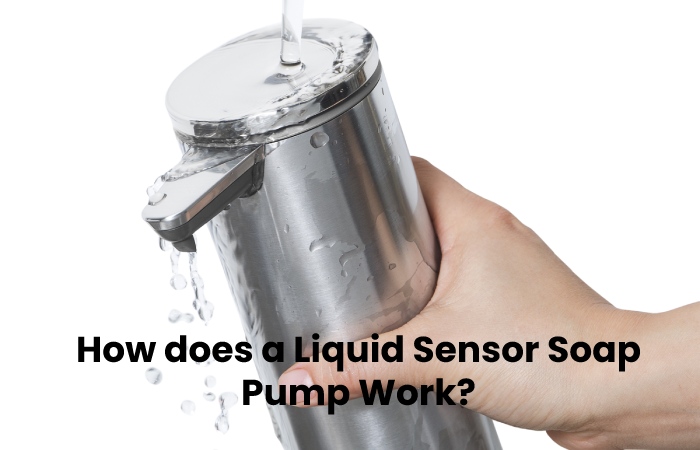Liquid Sensor Pump – A regulated amount of soap solution is automatically dispensed by an Liquid Sensor Pump soap dispenser, commonly referred to as a touchless or no-touch soap dispenser. The user’s hand is put in front of the sensor and beneath the nozzle when washing their hands. A pump mechanism will then be actuated by the sensor’s activation, dispensing a predetermined amount of soap from the nozzle automatically. Below, we’ll go through the three different kinds of automatic soap dispensers depending on the type of sensors they use: optical, radar-based, and passive infrared.
The radar-based sensor sends out bursts of microwave energy and waits for the power to reflect. For example, current sensors used in electronic soap dispensers use infrared light with a wavelength of 850 nm. The sensor in the involuntary soap dispenser employs an emitter and a collector. The emitter directs fourth pulses of infrared light while the collector, placed to face in the same direction as the emitter, sits dormant, waiting to sense the emitted pulse. No light reflection occurs when no hands remain in front of the device; therefore, no vibration remains sensed. But when indicators are currently in the path of the emitted light, a portion of the emitted infrared light is bounced back in the direction of the collector, which then triggers the generation voltage to switch the pump scheduled.
Table of Contents
How does a Liquid Sensor Soap Pump Work?

A photo sensor comprises a source of focused light and a light sensor. Once the hands remain placed in the line of the beam, the lightweight pump mechanism remains activated by the disruption that remains sensed by the light sensor.
A passive infrared sensor detects infrared energy emitted by one’s body heat. When the user’s hands remain placed in proximity of the sensor, the infrared energy quickly fluctuates. The rise of the infrared energy triggers the pump to start and distribute the chosen amount of liquid soap.
Liquid Sensor Pump Soap Dispensers, Specifically Reflex Soap Dispensers
Have three compensations over manual soap dispensers. Initial, the automatic soap dispensers are touchless, have preset increments, and are versatile. Second, touchless mechanisms or sensors remain activated, creating an even more sterile environment. Third, bacterial transmissions will remain eliminated without various individuals touching the pump. Finally, automatic soap dispensers will only distribute a set amount of soap per motion activation. Even models allow one to set the amount of soap to remain distributed to a highly efficient quantity in which waste will remain minimal.
Mechanisms of automatic soap dispensers that work for soap may also work for other liquids like the hand, lotion, laundry cleaner etc. This wide range of possibilities spreads the use of the soap distributer to various other locations other than the bathroom. But, again, adherence to supplier instructions remains advised on compatible dispenser liquids.
The Liquid Sensor Pump Soap Dispenser Presents the Accusense Dispense Technology,
Which produces ACCURATE and RESPONSIVE touchless sensor that quickly detects your hand. Its Touch-free and hygienic operation also comes with ADJUSTABLE Soap Volume that lets you quickly set the amount of soap dispensed to save you better with NO disordered spills or after drippings. So now you canister avoid cross infection with this touchless reflex soap dispenser. Furthermore, the Kitchen Soap Dispenser & Bathroom Soap Dispenser comes with a caddy where you can organize your sink essentials in an INSTANT!
These dispensers are ideal for use in the kitchen or bathroom. They remain mainly positioned or mounted near sinks. In the kitchen, soap dispensers can stay on either the countertop or the kitchen sink, while soap dispensers in the bathroom remain mounted or place near the bathroom sink. When in the kitchen, most are use earlier preparing food and before and after eating. While in the bathroom, automatic soap dispensers remain mainly used after defecating or urinating. Automatic soap dispensers virtually eliminate the possibility of bacterial transmissions between various people. Thanks to the progression in soap distributer technology, hand sanitizing has been made much calmer and safer than before.
Fixing your Liquid Sensor Pump Soap Dispenser
Repairing a malfunctioning soap dispenser remains easy as long as you know where to appear for the issue. Let’s take a closer look at bodily and automatic soap dispensers, as each type has its troubleshooting tips to get your soap pumping with ease.
Manual Soap Dispensers
Manual soap dispensers are essential, typically with a container (or bottle), tubing, and pump head or trigger. Unfortunately, any of these components could get a clog, so here’s how to check and fix the issue.
The Pump Bottle Remains Broken
We’ll cover the worst-case scenario first. If your flask remains broken, all of the soap has likely leaked out of it. On the additional hand, if you didn’t have much soap left in the bottle when the break occurred, you might not have noticed. The good news is you will know almost immediately upon inspection if this is the case. The bad news is you’ll need to replace the dispenser.
Conclusion
Liquid Sensor Pump – I don’t need the Simplehuman rechargeable liquid soap dispenser. But after using one for a few weeks, I feel spoilt and don’t want to live without it. Products from Simplehuman are precisely that—simple. They perform well, though, and they also look good. I like it.
Related posts
Featured Posts
Vanessa Bryant: Who is She? Vanessa Bryant Net Worth 2021
Vanessa Bryant Net Worth – The mother nationality of Vanessa is the American Vanessa Cornejo Urbieta. However, she was born…
What exactly is Google App Console? – Smart Tech Crunch – 2022
You may expand your Google Play company by using the Google Play App Console to publish your applications and games….


